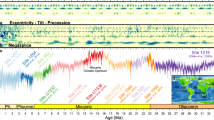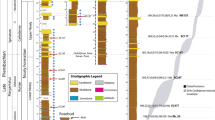Abstract
Global warming, the most severe faunal mass extinction and the shift of biogeochemical cycles were observed in the ocean across the Permian-Triassic boundary about 252 million years ago, providing an analog to understanding the modern oceans. Along with the progressive global warming, the biogeochemical cycle was documented to show a shift from the decoupled processes of carbon, nitrogen and sulfur prior to the mass extinction to the coupled biogeochemical processes during faunal mass extinction. The coupled biogeochemical cycle was further observed to shift from the coupled C-N processes during the first episode of the faunal mass extinction to the coupled C-N-S processes during the second episode, diagnostic of the progressive development of more deteriorated marine environmental conditions and the more severe biotic crisis across the Permian-Triassic boundary. The biogeochemical cycles could thus be an indication to the progressive collapse of marine ecosystems triggered by the global warming in Earth history. In modern oceans, the coupled C-N cycle triggered by the global warming was observed in some regions. If these local C-N processes develop and expand to the global oceans, the coupled C-N-S processes might be brought into existence and the marine ecosystems are inevitable to suffer from complete collapse as observed at 252 million years ago.
Similar content being viewed by others
References
Barnosky A D, Matzke N, Tomiya S, Wogan G O U, Swartz B, Quental T B, Marshall C, McGuire J L, Lindsey E L, Maguire K C, Mersey B, Ferrer E A. 2011. Has the Earth’s sixth mass extinction already arrived? Nature, 471: 51–57
Berner R A. 2002. Examination of hypotheses for the Permo-Triassic boundary extinction by carbon cycle modeling. Proc Natl Acad Sci USA, 99: 4172–4177
Burgess S D, Bowring S, Shen S. 2014. High-precision timeline for Earth’s most severe extinction. Proc Natl Acad Sci USA, 111: 3316–3321
Canfield D E, Stewart F J, Thamdrup B, De Brabandere L, Dalsgaard T, Delong E F, Revsbech N P, Ulloa O. 2010. A cryptic sulfur cycle in oxygen-minimum-zone waters off the Chilean coast. Science, 330: 1375–1378
Chen J, Shen S, Li X, Xu Y, Joachimski M M, Bowring S A, Erwin D H, Yuan D, Chen B, Zhang H, Wang Y, Cao C, Zheng Q, Mu L. 2016. High-resolution SIMS oxygen isotope analysis on conodont apatite from South China and implications for the end-Permian mass extinction. Palaeogeogr Palaeoclimatol Palaeoecol, 448: 26–38
Erwin D H. 2006. Extinction: How life on Earth nearly ended 250 million years ago. Biologist, 311: 1868–1869
Grasby S E, Sanei H, Beauchamp B. 2011. Catastrophic dispersion of coal fly ash into oceans during the latest Permian extinction. Nat Geosci, 4: 104–107
Jia C, Huang J, Kershaw S, Luo G, Farabegoli E, Perri M C, Chen L, Bai X, Xie S. 2012. Microbial response to limited nutrients in shallow water immediately after the end-Permian mass extinction. Geobiology, 10: 60–71
Jiang H, Lai X, Luo G, Aldridge R, Zhang K, Wignall P. 2007. Restudy of conodont zonation and evolution across the P/T boundary at Meishan section, Changxing, Zhejiang, China. Glob Planet Change, 55: 39–55
Jin Y G, Wang Y, Wang W, Shang Q H, Cao C Q, Erwin D H. 2000. Pattern of marine mass extinction near the Permian-Triassic boundary in South China. Science, 289: 432–436
Joachimski M M, Lai X, Shen S, Jiang H, Luo G, Chen B, Chen J, Sun Y. 2012. Climate warming in the latest Permian and the Permian-Triassic mass extinction. Geology, 40: 195–198
Krull E S, Lehrmann D J, Druke D, Kessel B, Yu Y Y, Li R. 2004. Stable carbon isotope stratigraphy across the Permian-Triassic boundary in shallow marine carbonate platforms, Nanpanjiang Basin, south China. Palaeogeogr Palaeoclimatol Palaeoecol, 204: 297–315
Luo G, Kump L R, Wang Y, Tong J, Arthur M A, Yang H, Huang J, Yin H, Xie S. 2010. Isotopic evidence for an anomalously low oceanic sulfate concentration following end-Permian mass extinction. Earth Planet Sci Lett, 300: 101–111
Luo G, Wang Y, Algeo T J, Kump L R, Bai X, Yang H, Yao L, Xie S. 2011. Enhanced nitrogen fixation in the immediate aftermath of the latest Permian marine mass extinction. Geology, 39: 647–650
Retallack G J, Jahren A H. 2008. Methane release from igneous intrusion of coal during Late Permian extinction events. J Geol, 116: 1–20
Song H, Wignall P B, Tong J, Yin H. 2013. Two pulses of extinction during the Permian-Triassic crisis. Nat Geosci, 6: 52–56
Sun Y D, Joachimski M M, Wignall P B, Yan C, Chen Y, Jiang H, Wang L, Lai X. 2012. Lethally hot temperatures during the Early Triassic greenhouse. Science, 338: 366–370
Svensen H, Planke S, Polozov A G, Schmidbauer N, Corfu F, Podladchikov Y Y, Jamtveit B. 2009. Siberian gas venting and the end-Permian environmental crisis. Earth Planet Sci Lett, 277: 490–500
Twitchett R J. 2007. The Lilliput effect in the aftermath of the end-Permian extinction event. Palaeogeogr Palaeoclimatol Palaeoecol, 252: 132–144
Ulloa O, Canfield D E, DeLong E F, Letelier R M, Stewart F J. 2012. Microbial oceanography of anoxic oxygen minimum zones. Proc Natl Acad Sci USA, 109: 15996–16003
Xie S, Pancost R D, Yin H, Wang H, Evershed R P. 2005. Two episodes of microbial change coupled with Permo/Triassic faunal mass extinction. Nature, 434: 494–497
Xie S, Pancost R D, Huang J, Wignall P B, Yu J, Tang X, Chen L, Huang X, Lai X. 2007b. Changes in the global carbon cycle occurred as two episodes during the Permian-Triassic crisis. Geology, 35: 1083–1086
Xie S C, Yin H F. 2014. Progress and perspective on frontiers of geobiology. Sci China Earth Sci, 57: 855–868
Xie S C, Liu D, Qiu X, Huang X Y, Algeo T J. 2016. Microbial roles equivalent to geological agents of high temperature and pressure in deep Earth. Sci China Earth Sci, 59: 2098–2104
Xie S C, Chen J F, Wang F P, Xun L Y, Tang K, Zhai W D, Liu J H, Ma W T. 2017a. Mechanisms of carbon storage and the coupled carbon, nitrogen and sulfur cycles in regional seas in response to global change. Sci China Earth Sci, 60: 1010–1014
Xie S, Algeo T J, Zhou W, Ruan X, Luo G, Huang J, Yan J. 2017b. Contrasting microbial community changes during mass extinctions at the Middle/Late Permian and Permian/Triassic boundaries. Earth Planet Sci Lett, 460: 180–191
Yin H, Xie S, Luo G, Algeo T J, Zhang K. 2012. Two episodes of environmental change at the Permian-Triassic boundary of the GSSP section Meishan. Earth-Sci Rev, 115: 163–172
Zhou W, Algeo T J, Ruan X, Luo G, Chen Z Q, Xie S. 2017. Expansion of photic-zone euxinia during the Permian–Triassic biotic crisis and its causes: Microbial biomarker records. Palaeogeogr Palaeoclimatol Palaeoecol, 474: 140–151
Acknowledgements
The work was supported by the State Key R & D Project (Grant No. 2016YFA0601100), the National Natural Science Foundation of China (Grant No. 41330103) and the 111 Project of China (Grant No. B08030)
Author information
Authors and Affiliations
Corresponding author
Rights and permissions
About this article
Cite this article
Xie, S. The shift of biogeochemical cycles indicative of the progressive marine ecosystem collapse across the Permian-Triassic boundary: An analog to modern oceans. Sci. China Earth Sci. 61, 1379–1383 (2018). https://doi.org/10.1007/s11430-017-9207-3
Received:
Revised:
Accepted:
Published:
Issue Date:
DOI: https://doi.org/10.1007/s11430-017-9207-3




